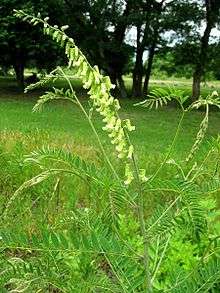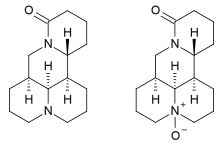Sophora flavescens
| Sophora flavescens | |
|---|---|
 | |
| Scientific classification | |
| Kingdom: | Plantae |
| (unranked): | Angiosperms |
| (unranked): | Eudicots |
| (unranked): | Rosids |
| Order: | Fabales |
| Family: | Fabaceae |
| Subfamily: | Faboideae |
| Tribe: | Sophoreae |
| Genus: | Sophora |
| Species: | S. flavescens |
| Binomial name | |
| Sophora flavescens | |
Sophora flavescens, the shrubby sophora,[1] is a species of plant in the genus Sophora a genus of the Fabaceae family, that contains about 52 species, nineteen varieties, and seven forms that are widely distributed in Asia, Oceanica, and the Pacific islands.About fifteen species in this genus have a long history of use in traditional Chinese medicines.[2] The root is known as Ku shen[3] and is a commonly-used traditional Chinese medicine.
Growth and cultivation
Sophora flavescens is an evergreen slow growing shrub growing to 1.5 m (4.9 ft) by 1 m (3.3 ft). It is hardy to 0–10 °F (−18 – −12 °C) and to US zone 6. The plant prefers light (sandy), medium (loamy) and heavy (clay) soils and requires well-drained soil. The plant prefers acid, neutral and basic (alkaline) soils. It cannot grow in the shade. It requires moist soil. Like many other species in the Fabaceae family, this species can fix nitrogen.
Research
Sophorae injection can reduce the toxicity and adverse effects caused by chemotherapy [4]
It is anti-inflammatory and an antioxidant.[5]
Anti-atherosclerosis [6] May be an effective cholesterol-lowering agent and useful for preventing hypercholesterolemic atherosclerosis.[7]
Sophora flavescens may have the potential for treatment of chronic inflammatory disorders such as rheumatoid arthritis.[8]
Neuroprotective in focal cerebral ischemia.[9]
A mix of Sophora flavescens and licorice (Glycyrrhiza glabra) gave better liver protective and anti-hepatocarcinogenic effects than licorice or Sophora alone. In addition, glycyrrhiza + sophora had a protective effect on immunosuppression, a strong non-specific anti-inflammatory effect, and reduced the incidence of sodium and water retention, protecting against pseudohypercorticosteroidism.[10]
Sophora could possibly be used as a treatment for mast cell-derived allergic inflammatory diseases.[11]
Inhibitory effects on cytochrome P450 3A4 (CYP450 3A4)[12]
The methanol extract of Sophora flavescens showed a potent glycosidase inhibitory activity.[13]
A promising source of a natural, novel, new antifoulant.[14]
May make skin whiter color by inhibition on tyrosinase-dependent melanin biosynthesis.[15] Therefore, a potential source of novel whitening agents for ultraviolet (UV)-sensitive skin [16]
Chemistry

A variety of chemical compounds have been isolated from S. flavescens, including:
- Matrine and matrine oxide, quinolizidine alkaloids found in the roots[17]
- Kushenin, a pterocarpan and isoflavonoid[18]
- Sophoraflavanone G[19]
- 7,9,2',4'-Tetrahydroxy-8-isopentenyl-5-methoxychalcone[20]
- Sophoridine[21]
- Trifolirhizin, a pterocarpan flavonoid, isolated from the roots[22]
- 8-Prenylkaempferol, a prenylflavonoid[23]
- Oxysophocarpine and sophocarpine, alkaloids[24]
Toxicity
Toxic effects from use of the root may include nausea, dizziness, vomiting, constipation, spasms, disturbance of speech, irregular breathing, respiratory failure and death.[25]
Notes
- ↑ "Sophora flavescens". Natural Resources Conservation Service PLANTS Database. USDA. Retrieved 21 November 2015.
- ↑ http://www.scielo.br/scielo.php?pid=S0102-695X2012005000043&script=sci_arttext
- ↑ You-Ping Zhu 1998 Chinese Materia Medica – Chemistry, Pharmacology and Applications ISBN 90-5702-285-0
- ↑ Zhu Z.-C., Wang H.-Z., Yang F."Composite sophorae injection in prevention of toxicity and adverse effects caused by chemotherapeutic agents" Journal of Practical Oncology 2009 24:6 (592–594)
- ↑ Dong H.L., Dong S.S., Dai Y.C., Beom J.K., Yun Y.L., Young H.K. "Anti-inflammatory and anti-oxidant effects of Sophora flavescens root extraction in lipopolysaccharide-activated raw 264.7 cells", Korean Journal of Medical Mycology 2010 15:2 (39–50)
- ↑ Han J.-M., An S., Kim M.-J., Jin Y.-Y., Baek S.-W., Park J.-S., Lee W.S., Park K.-H., Jeong T.-S."Sophora flavescens attenuates atherosclerosis and hyperlipidemia in LDL receptor-deficient mice" Arteriosclerosis, Thrombosis, and Vascular Biology 2008 28:6
- ↑ Kim H.Y., Jeong M., Jung H.J., Jung Y.J., Yokozawa T., Choi J.S."Hypolipidemic effects of Sophora flavescens and its constituents in poloxamer 407-induced hyperlipidemic and cholesterol-fed rats." Biological & pharmaceutical bulletin 2008 31:1 (73–78)
- ↑ Jin J.H., Kim J.S., Kang S.S., Son K.H., Chang H.W., Kim H.P."Anti-inflammatory and anti-arthritic activity of total flavonoids of the roots of Sophora flavescens" Journal of Ethnopharmacology 2010 127:3 (589–595)
- ↑ Park S.J., Nam K.W., Lee H.J., Cho E.Y., Koo U., Mar W. "Neuroprotective effects of an alkaloid-free ethyl acetate extract from the root of Sophora flavescens Ait. Against focal cerebral ischemia in rats" Phytomedicine 2009 16:11 (1042–1051)
- ↑ Wan X.-y., Luo M., Li X.-d., He P."Hepatoprotective and anti-hepatocarcinogenic effects of glycyrrhizin and matrine" Chemico-Biological Interactions 2009 181:1 (15–19)
- ↑ Hong, M.H.; Lee, J.Y.; Jung, H.; Jin, D.-H.; Go, H.Y.; Kim, J.H.; Jang, B.-H.; Shin, Y.-C.; Ko, S.-G (2009). "Sophora flavescens Aiton inhibits the production of pro-inflammatory cytokines through inhibition of the NF κB/IκB signal pathway in human mast cell line (HMC-1)". Toxicology in Vitro. 23 (2): 251–258. doi:10.1016/j.tiv.2008.12.002.
- ↑ Lee, S.S.; Zhang, B.; He, M.L.; Chang, V.S.C.; Kung, H.F. (2007). "Screening of active ingredients of herbal medicine for interaction with CYP450 3A4". Phytotherapy Research. 21 (11): 1096–1099. doi:10.1002/ptr.2149.
- ↑ Kim J.H., Ryu Y.B., Kang N.S., Lee B.W., Heo J.S., Jeong I.-Y., Park K.H. Glycosidase inhibitory flavonoids from Sophora flavescens Biological and Pharmaceutical Bulletin 2006; 29:2 302–305
- ↑ Feng D.Q., Ke C.H., Lu C.Y., Li S.J."Herbal plants as a promising source of natural antifoulants: Evidence from barnacle settlement inhibition." Biofouling 2009; 25:3 181–190
- ↑ Hyun S.K., Lee W.-H., Jeong D.M., Kim Y., Choi J.S. Inhibitory effects of kurarinol, kuraridinol, and trifolirhizin from Sophora flavescens on tyrosinase and melanin synthesis Biological and Pharmaceutical Bulletin 2008 31:1 (154–158)
- ↑ Hwang J.-H., Lee B.M."Inhibitory effects of plant extracts on tyrosinase, L-DOPA oxidation, and melanin synthesis" Journal of Toxicology and Environmental Health – Part A: Current Issues 2007 70:5 (393–407)
- ↑ Yoshikawa et al. (1985) Chem. Pharm. Bull. 33, 4267.
- ↑ Schwarte A 2002 Phytochemische und pharmakologische Untersuchungen der Wurzeln von Sophora flavescens,unter besonderer Berücksichtigung ihrer Wirkung auf die Leukotrien- und Prostaglandinbiosynthese Archived 14 August 2011 at the Wayback Machine.
- ↑ Cha, J.-D.; Moon, S.-E.; Kim, J.-Y.; Jung, E.-K.; Lee, Y.-S. (2009). "Antibacterial activity of sophoraflavanone G isolated from the roots of Sophora flavescens against methicillin-resistant Staphylococcus aureus". Phytotherapy Research. 23 (9): 1326–1331. doi:10.1002/ptr.2540.
- ↑ Choi, Byung-Min; Oh, Gi-Su; Lee, Jang Won; Mok, Ji Ye; Kim, Dae Keun; Jeong, Seung-Il; Jang, Seon Il (2010). "Prenylated chalcone from Sophora flavescens suppresses Th2 chemokine expression induced by cytokines via heme oxygenase-1 in human keratinocytes". Archives of Pharmacal Research. 33 (5): 753–60. doi:10.1007/s12272-010-0515-8. PMID 20512474.
- ↑ hang, Y.; Zhu, H.; Ye, G.; Huang, C.; Yang, Y.; Chen, R.; Yu, Y.; Cui, X. (2006). "Antiviral effects of sophoridine against coxsackievirus B3 and its pharmacokinetics in rats Z". Life Sciences. 78 (17): 1998–2005. doi:10.1016/j.lfs.2005.09.034.
- ↑ Zhou, H.; Lutterodt, H.; Cheng, Z.; Yu, L.L. (2009). "Anti-Inflammatory and antiproliferative activities of trifolirhizin, a flavonoid from Sophora flavescens roots". Journal of Agricultural and Food Chemistry. 57 (11): 4580–4585. doi:10.1021/jf900340b. PMC 2704566.
- ↑ Chiou, Wen-Fei; et al. (2011). "8-Prenylkaempferol Suppresses Influenza A Virus-Induced RANTES Production in A549 Cells via Blocking PI3K-Mediated Transcriptional Activation of NF-κB and IRF3". Evid Based Complement Alternat Med. Hindawi Publishing Corporation. 2011: 920828. doi:10.1093/ecam/nep066. PMC 3137797. PMID 19592477.
- ↑ Liu, G.; Dong, J.; Wang, H.; Hashi, Y.; Chen, S. (2011). "Characterization of alkaloids in Sophora flavescens Ait. by high-performance liquid chromatography-electrospray ionization tandem mass spectrometry". Journal of Pharmaceutical and Biomedical Analysis. doi:10.1016/j.jpba.2010.12.024.
- ↑ Bensky, Dan; Clavey, Steven; Stöger, Erich; Lai Bensky, Lilian (2015). Chinese Herbal Medicine: Materia Medica (Portable 3rd ed.). Seattle, USA: Eastland Press. pp. 575–578. ISBN 978-0-939616-82-4.
References
- Terada, M.; Sano, M.; Ishii, A.I.; et al. (1982). "Studies on chemotherapy of parasitic helminths. (IV). Effects of alkaloids from Sophora flavescens on the motility of parasitic helminths and isolated host tissues". Nippon Yakurigaku Zasshi. 79: 105–111.
- medicinal plants in the Republic of Korea
- Ya Ling, Jian; Ying Zhang, Guo; Jie Cui, Zhao; Kai Zhang, Chang (2007). "Supercritical fluid extraction of quinolizidine alkaloids from Sophora flavescens Ait. and purification by high-speed counter-current chromatography" (PDF). Journal of Chromatography A. 1145: 123–127. doi:10.1016/j.chroma.2007.01.080.